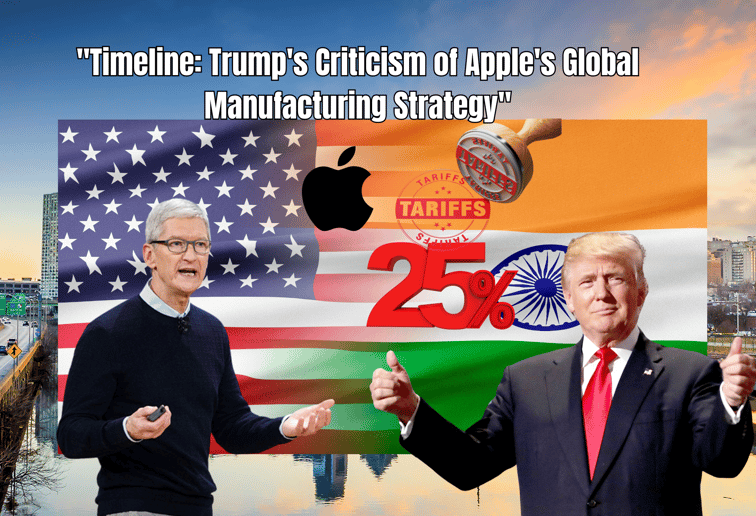
A Comprehensive Timeline: Trump's Criticism of Apple's Global Manufacturing Strategy
INTERNATIONAL TRADE & TRADE POLICIES
GlobalSetu Enterprise [V.S.V]
5/23/20252 min read


In today's interconnected world, the clash between political rhetoric and corporate strategy often creates compelling narratives. One such debate recently unfolded as former President Donald Trump targeted Apple’s decision to expand its manufacturing operations in India. In this post, we explore the key events that led to this controversy, offering insight into how political pressures intersect with global business strategies.
Timeline of Key Events:
Pre-March 2025: Apple's Strategic Expansion in India
Before March 2025, Apple was aggressively bolstering its manufacturing capacity in India. Reports showed that the value of iPhones produced in India had reached approximately $22 billion for the fiscal year ending in March 2025—a remarkable 60% increase from the previous year. This surge was part of Apple’s deliberate strategy to diversify its production base, reduce reliance on any single country, and tap into the cost efficiencies and expansive labor pool available in emerging markets.
Early May 2025: Public Criticism at a Business Summit in Qatar
In early May 2025, during a prominent business event in Qatar, former President Donald Trump publicly expressed his discontent with Apple’s manufacturing plans. At this event, Trump reportedly remarked that he had “a little problem” with Apple CEO Tim Cook, urging that iPhones destined for the U.S. market should be produced domestically rather than overseas. His comments highlighted a preference for American manufacturing and set off a wave of media and industry attention.
May 21-22, 2025: Social Media Ultimatum and Tariff Warnings
Shortly after the Qatar event, Trump took to his social media platform, Truth Social, to reiterate his stance. In his posts, he stressed that he had long advised Tim Cook that iPhones sold in the United States must be manufactured on American soil. Furthermore, he issued a stark warning: if Apple did not shift its production back to the U.S., the company would face tariffs of at least 25%. This public ultimatum intensified the debate, casting a spotlight on the feasibility of relocating a massive and complex supply chain.
Post-May 2025: Apple's Reaffirmation and Foxconn's Robust Investment in India
Despite the political pressure and the tariff threat, Apple maintained its commitment to its global manufacturing strategy. The company reaffirmed that its investments in India were both strategic and essential for cost efficiency and supply chain resilience. Concurrently, Apple’s key manufacturing partner, Foxconn, announced a significant investment of approximately $1.5 billion to expand its production capacity in India. Plans were put in place to produce between 25 and 30 million iPhones during 2025, underscoring Apple’s reliance on India as a critical production hub.
Industry Analysis and Broader Implications
The controversy has prompted widespread discussion among industry experts and market analysts. Many have pointed out that moving significant portions of iPhone production to the United States could lead to dramatically higher manufacturing costs. Some estimates suggest that U.S.-made iPhones might retail for around $3,500—far above current market prices—due to the complexities of establishing a new supply chain and the higher cost of American labor and infrastructure. This scenario starkly contrasts with Apple’s global strategy, which prioritizes efficiency, scalability, and competitive pricing in international markets.
Conclusion:
The detailed timeline above illustrates the multifaceted nature of the debate surrounding Apple’s manufacturing strategy. While Trump's calls for U.S.-based production resonate with a political agenda centered on economic nationalism, Apple’s steadfast approach to a diversified, global supply chain reflects the practical imperatives of operating in a complex, cost-sensitive industry. As these events continue to unfold, they serve as a poignant example of how global corporations must navigate the often conflicting demands of political expectations and business logic.
GlobalSetu Enterprise
"A Bridge to Global Prosperity"
Mumbai, Maharashtra, India
We’re Here to Help! At GlobalSetu Enterprise, we value communication and collaboration. Whether you have questions about our products and services, want to discuss business opportunities, or simply wish to say hello don’t hesitate to reach out!